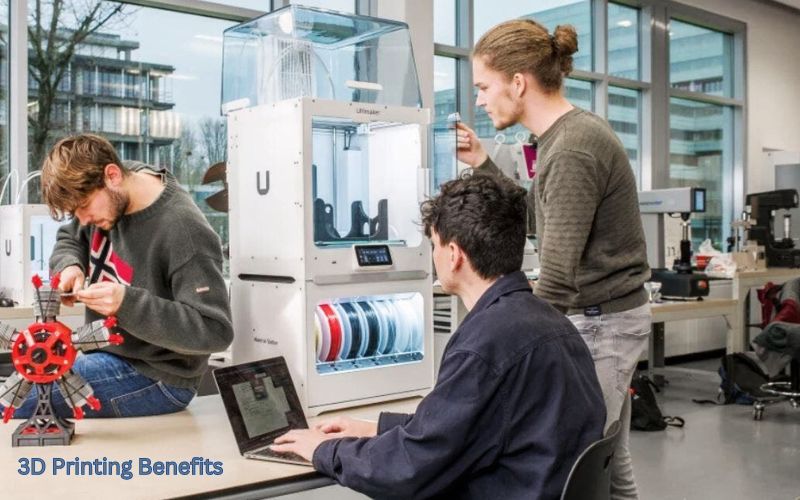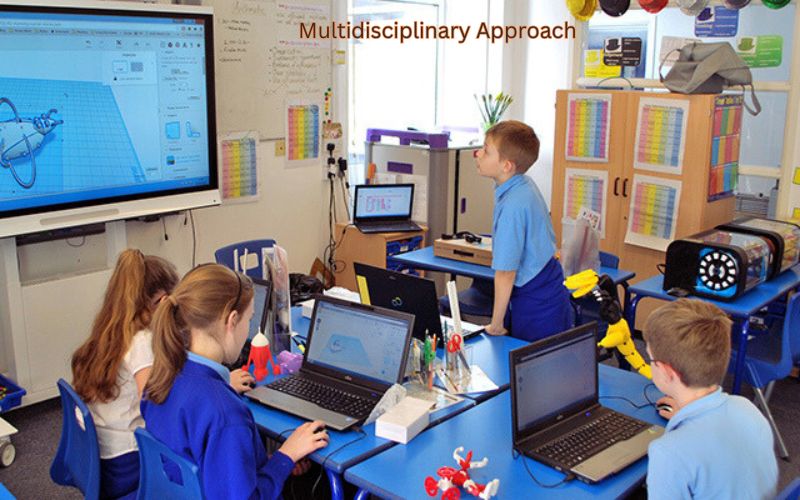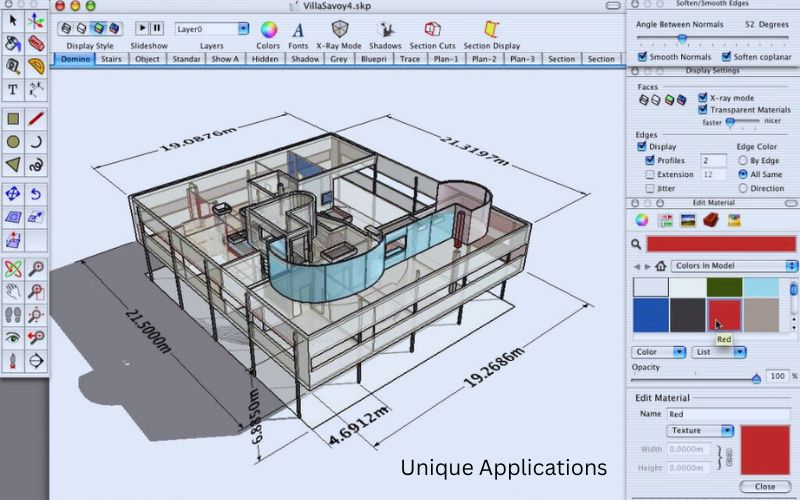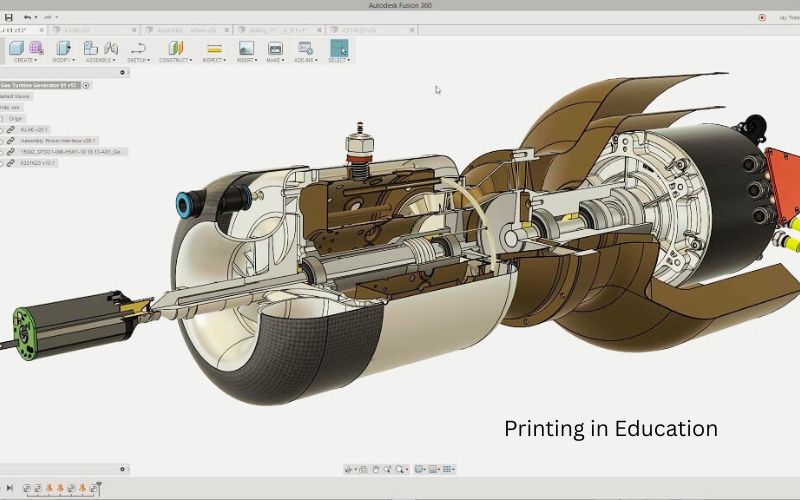3D Printing in Education: The market for 3D printing is projected to grow by $1.10 billion between 2024 and 2028 due to its creativity and flexibility. This technology reshapes students’ education as it allows them to learn in active ways which enhances their creativity and improves their problem-solving abilities.
In my capacity as a 3D printing professional, I can attest to the vast possibilities this technology has in various educational environments. 3D printers are beneficial to educators and institutions who want to be at the forefront of education and prepare their students for the future.

Benefits of 3D Printing in Schools
Boosting Student Engagement and Creativity
The use of 3D printing is revolutionizing the way students study. This technology enables them to see an image as a real object. This enhances their ability to understand concepts.
The use of 3D technology enhances the creativity of the pupils. For instance, they can design and print their own board game or models of animals from the biology section.
Teachers also use 3D-printed items as incentives. Little structures or unique figures are appealing to students and encourage them to participate more in class.
Students can collaborate and use 3D printing to create fragments of larger projects, such as a bridge model or a relic from the past. It is much richer when pupils can interact with the project and customize it in person. For schools or startups looking to invest, choosing the best 3d printer for small businesses ensures reliable, high-quality results for such hands-on learning experiences.
In summary, 3D printing stimulates student curiosity and creativity in classrooms. It enhances learning.
Enhancing Problem-Solving Skills
With 3D printing, students can construct digital models that require both critical and creative thinking. Students can design, evaluate, and modify their models.
As an example, students may create a modular bridge. They must present their work in the form of sketches. After this stage, they move forward with computer-aided design and other details of the model.
They build the bridges and check them up for strength. Through these techniques, they gain a deeper understanding of the problems they face and how to solve them. They learn how to resolve problems, such as changing the bridge’s design and materials.
Students may design 3D-printed objects that assist persons with disabilities. This not only helps solve social problems but also opens opportunities to make money from a 3D printer by creating useful, in-demand products. It teaches them to understand others’ needs while earning income.
Through activities like 3D printing in class, professionals impart determinant skills to pupils, helping them solve problems. It prepares students for the challenges they will face in the future. It fosters both imagination and practical skills in students.
Preparing Students for Future Careers
In the future, 3D printing will be integrated with teaching to help students prepare for advanced degrees. By involving students in practice through collaboration between schools and industries, they are encouraged to participate in the implementation of designs.
For instance, they can design their own models and produce them in a printing studio. Most importantly, it enhances their imagination and improves their understanding of problems.
Students must learn and apply 3d printing skills to engineering and design fields, increasing their competitiveness in the job market. 3D printing is more than just creating; it’s also about thinking.
It is common for students to become self-employed as well. In today’s world, this approach is significant because it offers a low cost, allowing products to be generated and evaluated quickly. 3D printing is more than a technology; it is also a means of training students for future employment.

3D Printing Across Curricula: A Multidisciplinary Approach
| Subject | Applications of 3D Printing |
| Science | Crafting models of molecules, human anatomy, or custom laboratory tools. |
| Mathematics | Bringing complex geometric shapes and mathematical theories to life through visualization. |
| Engineering | Prototyping designs and addressing engineering problems with iterative solutions. |
| Art | Creating innovative sculptures and designs to inspire artistic creativity. |
| History | Reproducing historical artifacts and structures for interactive exploration. |
Types of 3D Printers Suitable for Educational Use
Desktop 3D Printers for Classroom Settings
3D printers, on the other hand, are changing classrooms for the better. They make the learning experience practical and enjoyable. Models like MakerBot Sketch and IMAGIN3D are suitable for educational institutions. The machines are easy to use, and they come with accompanying certifications and lesson plans.
There are two printers and enough filament in the MakerBot Sketch Sprint so that students can teach and learn visually. The IMAGIN3D printer is also quite flexible. It works well for models and maps, as well as for creating interactive lessons for teachers.
By using these innovative devices, students can also be creative and find practical solutions. They can construct projects in the real world. They develop analytical skills and commercial ideas. In other words, desktop 3D printers enhance the learning experience. They prepare learners for the job market.
Advanced Printers for Specialized Courses
With SLA and SLS printers, specific courses are being revolutionized. Such printers are ideal for intricate designs since they provide high fidelity. SLA printers produce uniform molds with high resolution. Medical students can benefit from this when constructing anatomical models. In engineering, SLS printers enable students to fabricate various components and create complex geometries without the need for support structures.
The materials employed by educational printers range from resins to powders to create durable models. SLA printers use resins to build tough models. Using these printers in the courses enables students to be creative and understand practical aspects of processes. They are essential instruments in contemporary education enabling students to excel in the fields of health and design in the future.

Unique Applications of 3D Printing in Education
Interdisciplinary Projects and Collaborations
In schools, 3D printing enables students to collaborate on common goals by integrating different subjects. By doing so, engineering, art, and other students can work on common objectives. As a result, they can learn more interestingly.
Auburn University and the University of Idaho used 3D printing to build inexpensive houses made of eco-friendly materials. This project combines engineering, chemistry, and environmental science.
In another example, students from Sachem High School constructed 3D printers using parts they manufactured. By building these printers, students made stronger bonds with the community.
Through these projects, students gained knowledge that extended beyond what they learned in class. They took part in fieldwork in addition to attending classes. Such collaboration prepares them for tomorrow’s careers and develops creativity.
Using 3D Printing for Community and Environmental Projects
3D printing is a cutting-edge technology with far-reaching effects around the world. The e-NABLE community is a non-profit organization with members across the globe. It is their responsibility to 3D print prosthetic devices for those in need.
These devices are cheap and can be personalized to your preference. A 3D-printed structure can be built quickly and easily in Nacajuca, Mexico. The Vulcan II printer uses very little raw material, making it easier to conserve resources.
There are a variety of ply wooden projects that often use biodegradable plastic materials as staples. Solar energy-powered 3D printers are also becoming more prevalent. This helps to eliminate the use of fossil fuels. Waste can be converted into filaments for 3D printing. This promotes a circular bio-economy.
3D printing is the answer to many eco-challenges that people face today. It helps to bring about change that is both accessible and effective in creating a better world.
Overcoming Challenges in Implementing 3D Printing
Addressing Cost and Resource Concerns
In schools, 3D printing raises concerns about cost and resources that need to be addressed. The costs can be cut by 86% if a school uses a 3D printer to make its own learning aids rather than purchasing them. Many open-source designs are available for free on various websites.
Choose a 3D printer with safety features that will cost between $2,000 and $3,500. Use PLA filament, which is economical and safe.
Collaboration with local businesses is another way to reduce costs. One company may offer what the other lacks at a discount, or a makerspace may offer equipment and materials for free.
By utilizing open-source designs, schools can develop innovative and cost-effective 3D printing solutions.
Training Teachers and Staff
Training teachers on 3D printers is essential for schools. This enables them to incorporate this technology into their classes, which in turn motivates the students.
Importance of Training
Teaching with 3D printers encourages creativity, critical thinking, and creativity in the students. Teacher training can also enhance the ability to lead fun-filled and engaging projects.
Types of Training
Online courses are also available. Videos about design can be found at Makers Empire. Hands-on workshops can be found at Learnbylayers. Teachers can also access resources at their convenience.
Benefits for Teachers and Students
Teachers benefit from training as it enhances their teaching skills, and students gain practical experience that can be valuable for their future careers.
Innovative Resources
Educators can access free educational materials, including lesson plans and video explanations, through platforms like Create Education.
3D printing approaches can enhance the learning process by allowing teachers to develop new and interesting methods of teaching.

Future of 3D Printing in Education
Expanding Curriculum Integration
3D printing can enhance understanding in various subjects as well as foster creativity and imagination in the classroom.
Integrating Across Subjects
The use of 3D printing in education, art, and literature is beneficial. History students can recreate precious objects, while artists can create models and design sculptures using print techniques. Literature students may make prints of models of their favorite books.
Enhancing STEM Education
STEM (Science, Technology, Engineering, Mathematics) classes can utilize 3D models to explain concepts such as volume and symmetry. Physical sciences students can use such models to demonstrate intricate processes.
Fostering Creativity and Problem-Solving
3D printing stimulates creative thinking in students, which increases confidence and provides a necessary insurance for future success.
Unique Applications and Benefits
Through 3D printing, students can relate their academic studies to real-world issues and develop feasible solutions for their society. This fosters teamwork and understanding.
By using 3D printing to enhance the learning process, students are equipped with future skills, utilizing digital tools and enhancing their creativity. This technology enhances their interest in education.
Encouraging Innovation and Lifelong Learning
In today’s global economic climate, we must all be creative and responsive in our approaches. Lifelong learning develops the skills needed to cope with the current challenges.
For businesses, lifelong learning is an essential element of building up creative, resourceful teams rather than just acquiring new skills.
Wrapping Up
3D printing is redefining the learning paradigms for students. It enables students to create something concrete from abstract concepts, making classes more enjoyable by enhancing creativity and problem-solving, while also providing practical experience.
Additionally, it teaches professional skills such as creative thinking and design, which will be essential for future careers. 3D printing makes education exciting and progressive, despite being expensive and difficult to access.
Frequently Asked Questions
What is 3D printing in an educational setting?
3D printing (or Additive Manufacturing) is a process where a physical, three-dimensional object is created from a digital design file (CAD model) by adding successive layers of material. In schools, it is used as a hands-on, active learning tool to transform abstract concepts into tangible models for subjects across the curriculum.
Why is 3D printing considered beneficial for students?
It enhances student engagement by turning ideas into real objects, boosts creativity and problem-solving skills through design and iteration (trial and error), and fosters critical thinking as students must design, evaluate, and modify their models. It also provides practical experience with modern engineering and design processes, preparing them for future careers.
How can 3D printing be used across different subjects?
Science (STEM): Printing models of molecules, human anatomy (organs), cross-sections of Earth, or simple machines (gears, levers). Mathematics: Visualizing complex geometry, fractions, scale, and volume. History: Reproducing historical artifacts, ancient structures (e.g., the Acropolis), or fossils for hands-on examination. Art & Design: Creating innovative sculptures, prototypes, or customized functional parts.
What challenges should schools be prepared for when implementing 3D printing?
The primary challenges are managing print queues (as prints can take a long time), training teachers to confidently incorporate the technology into their lessons, and the initial cost of equipment and materials. Strategies to overcome this include training students to run the printers themselves and using class management tools like Tinkercad Classrooms.
What safety precautions should be taken when using 3D printers in a school?
Key safety concerns include Ultrafine Particles (UFP) and Volatile Organic Compounds (VOCs) released during printing. Best practices involve: 1) Using low-emission filaments like PLA instead of ABS. 2) Ensuring the printer is in a well-ventilated area or using printers with a built-in enclosure and filtration system. 3) Educating students on the risks and using enclosures to prevent contact with hot extruder nozzles and moving parts.
